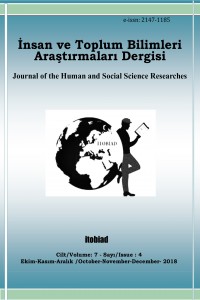Öz
Bu çalışmanın amacı,
gençler arasında sosyal statü göstergelerini ve kendilerini akranları arasında
nasıl bir sosyal statüde gördüklerini belirlemek için Sweeting ve arkadaşları
tarafından geliştirilen “Scale of Subjective Social Status” ölçeğini Türkçeye
uyarlamaktır. Ölçeğin orjinali İngilizcedir ve üç faktörlü toplam 7 ifadeden
oluşmaktadır. Türkçeye çevrilen ifadelerin Türkçeye uygunluğu, anlam bütünlüğü
ve dil geçerliliğini sağlamak için İngilizce dil uzmanlarının görüşleri
alınarak ölçeğe son şekli verilmiştir. Ölçeğin Türkçe formu 321 öğrenciye
uygulandıktan sonra ölçeğin yapı geçerliği faktör analiziyle yapılmış ve analiz
sonucunda Türkçeye çevrilen ölçeğin de 7 ifadeden oluşacağı
kararlaştırılmıştır. Ölçeğin iç tutarlılığını belirlemek için ölçeğin her bir
faktörü ve ölçeğin tümü için Cronbach Alpha güvenirlik katsayılarının (.72)
yeterli olduğu sonucuna varılmıştır. Yapılan analizlerin sonuçlarına göre;
Türkçeye uyarlanan ölçek, ergenlerin kendilerini akranlarıyla
kıyasladıklarında, kendilerini hangi sosyal statüde algıladıklarını belirlemede
geçerli ve güvenilir bir ölçektir.
Anahtar Kelimeler
Kaynakça
- Bilgin, N. (1991). Eşya ve insan. Ankara: Gündoğan Yayınları.
- Botton, A. Statü Endişesi. (2005). Çev. Ahu Sıla Bayer. İkinci Baskı. İstanbul: Sel Yayıncılık.
- Chan, T. W. (Ed.). (2010). Social status and cultural consumption. Cambridge University Press.
- Eder, D. (1985). The cycle of popularity: Interpersonal relations among female adolescents. Sociology of education, 154-165.
- Fichter, H.J. (2015). Sosyoloji nedir. Çev.Nilgün Çelebi. 2.Baskı. Ankara: Anı Yayıncılık.
- Goodman, E., Adler, N. E., Kawachi, I., Frazier, A. L., Huang, B., & Colditz, G. A. (2001). Adolescents' perceptions of social status: development and evaluation of a new indicator. Pediatrics, 108(2), e31-e31.
- İbn Haldun. (2013). Mukaddime 1, (S. Uludağ, Çev.), İstanbul: Dergâh Yayınları.
- Jöreskog, K. G., & Sörbom, D. (1993). LISREL 8: Structural equation modeling with the SIMPLIS command language. Scientific Software International.
- Lembet, Z. (2014). Dergi reklamlarında sosyal statü göstergesi olarak markaların sunumu, Doktora Tezi, İzmir: Ege Üniversitesi Sosyal Bilimler Enstitüsü.
- Sweeting, H., West, P., Young, R., & Kelly, S. (2011). Dimensions of adolescent subjective social status within the school community: Description and correlates. Journal of adolescence, 34(3), 493-504.
- Sweeting, H., & Hunt, K. (2014). Adolescent socio-economic and school-based social status, health and well-being. Social science & medicine, 121, 39-47.
- Tabachnick, B. G., & Fidell, L. S. (2007). Using multivariate statistics (5th ed.). Boston, MA, : Allyn & Bacon/Pearson Education.
Öz
This study aims to adapt the scale of subjective
social status, which was developed by Sweeting and her colleagues to Turkish,
to ascertain the social status indicators of youth and how they see their
social status among peers. The original scale is in English and the
three-factor total is composed of 7 words. To ensure a successful adaptation,
English language experts have been consulted about the appropriateness of the
translated statements in Turkish, the meaningfulness and the validity of the
language. The validity of the scale was assessed by factor analysis after the
Turkish form of the scale was administered to 321 students and as a result of
the analysis, it was agreed on that the scale to be translated into Turkish
also consists of 7 words. It was concluded that the Cronbach Alpha reliability
coefficients (.72) were sufficient for each scale factor and the entire scale,
to determine the internal consistency of the scale. Based on the findings, it
may be said that the correlation coefficient between the re-test method and the
applications performed is also sufficient.
Anahtar Kelimeler
Kaynakça
- Bilgin, N. (1991). Eşya ve insan. Ankara: Gündoğan Yayınları.
- Botton, A. Statü Endişesi. (2005). Çev. Ahu Sıla Bayer. İkinci Baskı. İstanbul: Sel Yayıncılık.
- Chan, T. W. (Ed.). (2010). Social status and cultural consumption. Cambridge University Press.
- Eder, D. (1985). The cycle of popularity: Interpersonal relations among female adolescents. Sociology of education, 154-165.
- Fichter, H.J. (2015). Sosyoloji nedir. Çev.Nilgün Çelebi. 2.Baskı. Ankara: Anı Yayıncılık.
- Goodman, E., Adler, N. E., Kawachi, I., Frazier, A. L., Huang, B., & Colditz, G. A. (2001). Adolescents' perceptions of social status: development and evaluation of a new indicator. Pediatrics, 108(2), e31-e31.
- İbn Haldun. (2013). Mukaddime 1, (S. Uludağ, Çev.), İstanbul: Dergâh Yayınları.
- Jöreskog, K. G., & Sörbom, D. (1993). LISREL 8: Structural equation modeling with the SIMPLIS command language. Scientific Software International.
- Lembet, Z. (2014). Dergi reklamlarında sosyal statü göstergesi olarak markaların sunumu, Doktora Tezi, İzmir: Ege Üniversitesi Sosyal Bilimler Enstitüsü.
- Sweeting, H., West, P., Young, R., & Kelly, S. (2011). Dimensions of adolescent subjective social status within the school community: Description and correlates. Journal of adolescence, 34(3), 493-504.
- Sweeting, H., & Hunt, K. (2014). Adolescent socio-economic and school-based social status, health and well-being. Social science & medicine, 121, 39-47.
- Tabachnick, B. G., & Fidell, L. S. (2007). Using multivariate statistics (5th ed.). Boston, MA, : Allyn & Bacon/Pearson Education.
Ayrıntılar
| Birincil Dil | Türkçe |
|---|---|
| Bölüm | Makaleler |
| Yazarlar | |
| Yayımlanma Tarihi | 30 Aralık 2018 |
| Yayımlandığı Sayı | Yıl 2018 Cilt: 7 Sayı: 4 |























